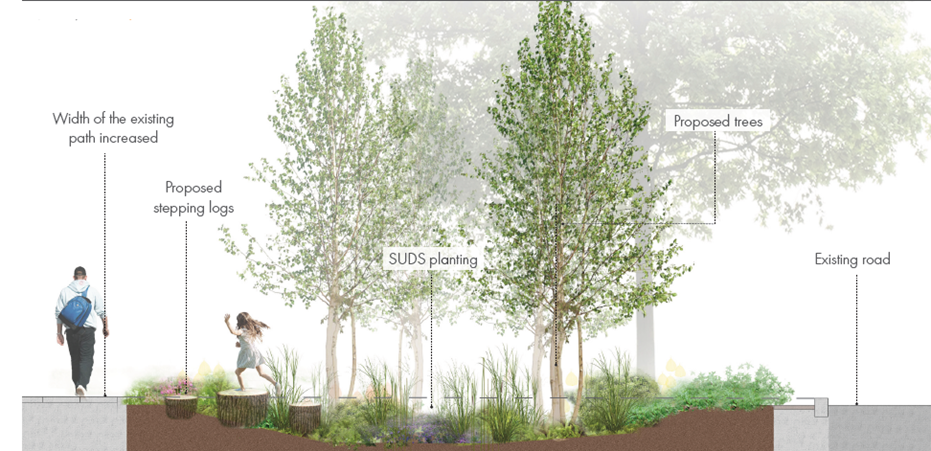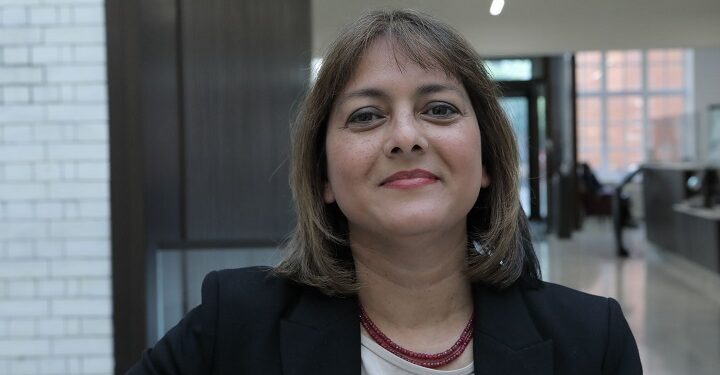
The programme draws on investigations of the sources of surface water flooding and areas at highest risk to take a “catchment-wide” approach to positioning new nature-based solutions such as rain gardens in locations which collectively reduce the amount of water reaching at-risk locations.
Referred to as Sustainable Drainage Systems or SuDs, these solutions which range from trees to wetlands mimic natural drainage cycles alleviating pressure on our aging sewage system.
This programme will provide new green infrastructure on our streets and open spaces that not only support the continued efforts to reduce flood risk for the borough’s residents and businesses, but also offer wider benefits such as cooling areas during heat waves, storing carbon and supporting mental health and wildlife.
This programme is required to reduce the current risk of surface water flooding in the borough, but also to improve resilience to climate change; research by the Met Office and Environment Agency shows Lambeth will see a 40 percent rise in storm intensity by 2100, which means more frequent and severe storms and surface water flooding – caused when the rainwater is prevented from draining naturally to the ground due to buildings, roads, driveways, or pavements. This leads to the storm systems becoming overwhelmed.
Lambeth is almost entirely reliant on the Victorian combined sewer network for drainage, and according to Thames Water is ranked 3rd out of 32 London Boroughs for the least available sewer capacity.
As Lambeth is highly urbanised it is not possible to install conventional flood mitigation measures and upgrading existing buried infrastructure is unsustainable. Instead, Lambeth’s strategy to reduce flood risk relies on lots of smaller and sustainable interventions across the borough that accumulatively provide catchment wide benefits.
The Sustainable Drainage Programme will build these SuDS across highways and streets, open spaces, estates, and schools to sustainably manage storm water for the long-term and form part of the Council’s response to the impacts of climate change.
102295_SuDS_ProgrammeMap v2Lambeth Council has allocated £3.55 million from its climate response programme with a further £2.45 million awarded by Thames Water to implement the new drainage systems.
Cllr Rezina Chowdhury, cabinet member for Sustainable Lambeth and Clean Air, said: “This programme has the potential to address the very real threat of rising flood risk over the coming years, protecting households now and in the future.”
“We are committed to making sure our climate response is at the heart of everything we do, as reflected in our Climate Action Plan. This Programme will sustainable manage over 4 hectares of Lambeth’s surfaces, and will go towards our Climate Action Plan target of achieving 10% of impermeable surfaces to be sustainably managed by 2030.”
“The consequences of climate change are often felt hardest among those most vulnerable, so we are acting now. This means prioritising those in most need, investing in sustainable infrastructure and redesigning our streets.”
Nevil Muncaster, London Operations Director at Thames Water, said: “We’re proud to be part of this innovative partnership with Lambeth Council and over the next 3 years we plan to provide a template for creating greener, more resilient communities across our region.
“At Thames Water we operate in one of the most densely populated and built-up regions in the UK, which places huge pressure on drainage.
“Population growth, urban creep and climate change are increasing the risk of surface water flooding, sewer flooding and pollution. Action is urgently needed to stop rainwater, which doesn’t need to be sent to a sewage works for treatment, getting into the sewers in the first place.
“Sustainable drainage systems which replicate the natural environment are key to achieving this, but we can’t do it alone. Working with partners like Lambeth Council and other local authorities is vital for ensuring we provide the greatest benefits for Local Authority residents and our customers as we tackle these challenges together into the future.”
Read more about Flood risk in the borough and SuDS



